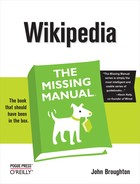Most of the first 17 chapters of this book offered you an assortment of how-to advice on improving Wikipedia articles. Now it’s time to tie all that advice together, and to fill in some of the gaps.
If you’re a less experienced editor, this chapter can serve as a detailed checklist. When you’re looking at an article you want to improve, you have a step-by-step process for going from the top to the bottom of that article. For experienced editors, the section headings in this chapter can serve as a reminder of everything that goes into making a good Wikipedia article.
This chapter is particularly intended for articles that are short and/or relatively unsourced. It also contains a lot of advice about minimizing disagreements with other editors—a good idea even if you’re working on an article where other editors are scarce to non-existent. Consider the advice about disagreements as safety insurance, in case a cranky fellow editor comes out of the woodwork.
You don’t want to spend time researching and editing an article, and then discover (or be told about) something that sharply reduces the value of much or all of what you’ve done. Here’s a list of questions to ask yourself, to avoid unpleasant surprises:
Has the article been vandalized? Check for both recent edits and for edits in the past that removed a large chunk of good information. If the vandalism is recent, revert it, or use the good information to improve the article.
Chapter 5 discussed how to use the article history page to analyze what’s happened recently. You can check for the second issue—missing material—by looking at whether the size of the article has decreased (a sharp drop in byte count). Vandals and POVers do remove good content and don’t always get caught. If you’re planning to spend a couple of hours on an article, take a minute or two to glance at older versions of the article. If it’s been stable or showing accumulating information, with no signs of vandalism, go right ahead and continue working on it.
Is the article a massive copyright infringement? If so, revert to a version without the copyright problem, or, if it started out life that way, nominate it for speedy deletion (under criterion G12, as shown in Figure 19-3 on page 365).
If the article links only to the one company or product or Web site most closely associated with the topic, then click that link to see if that’s where most of the text was taken from. Warning signs of copyright infringements include: The article was created relatively recently; it has a concentrated number of edits from an editor who has done little else beside this article; it reads like something taken from a company or organization marketing Web page. If any of these apply, go to the page history, find a large chunk of added text, and then do a Web search for that text. Most results will probably be Wikipedia mirror sites, but you may get lucky and find the real Web site with the text on it. Bingo—copyright infringement. (For more information, see the page Wikipedia:Spotting possible copyright violations—shortcut WP:SPCV.)
Does the article have a unsolvable problem with sourcing? Does it have no sources, or only bad sources (blogs, Web sites that can’t be considered reliable sources, and so on), or a mixture of bad and incorrectly used sources? (For example, it cites a newspaper article which mentions the Wikipedia topic only very briefly, because the article is really about something else.) If the article has no sources or poor ones, and you can’t find any reliable ones, the topic may not be notable enough for Wikipedia.
Even if you think the topic is notable, if the article is essentially lacking any reliable source, search the Web. If you can’t find anything, you need to dig deeper, or turn to Chapter 19 on deleting articles.
Tip
Also remember WP:NOT, that Wikipedia isn’t a dictionary. Dictionary definitions, no matter how well cited, are still dictionary definitions. Consider moving the definition to Wiktionary (???).
Does the article already exist under another name? The longer an article has been around, the less likely that it’s a duplicate, but if it’s less than a couple months old, use your favorite search engine to do a quick domain-restricted search for example, blue-footed booby site:en.wikipedia.org. The search helps you figure out whether it’s a duplicate or whether there are other Wikipedia articles that should link to the one you’re working on. If so, add the wikilinks.
If you do find another article that largely duplicates the one you’re planning to work on, then you need to read the page Help:Merging and moving pages (shortcut: H:MMP) and do, or propose, a merger. And if you’re bold and actually do the merger, wait a couple of days before starting to edit the merged article, to see if other editors show up to oppose what you’ve done. (For more on merging, see Overlapping Content: Merging.)
Is the article the center of disagreements? If you decide to work on a controversial article, you may spend more time negotiating with other editors than editing the article. The article history (lots of reverts, full protection because of an edit dispute, and so on) and the article talk page should make clear how controversial an article is. Also check the history of the article talk page, for any active discussions.
The fact that an article’s contents are being vigorously disputed isn’t necessarily a reason to work on something else. It just means that you must be extra careful with your edits, and be willing to spend as much time as necessary discussing changes with editors who may have ownership issues; see the guideline Wikipedia:Ownership of articles (shortcut WP:OWN). If you have doubts, consider working on something else. (There’s plenty—see the box below.)
